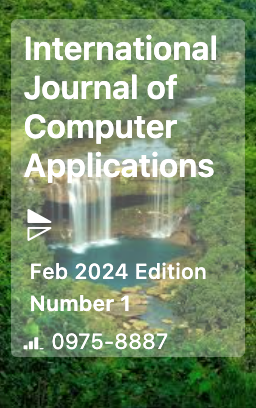Reseach Article
Natural Language Processing in Conversational Systems: An Overview
| Journal of Advanced Artificial Intelligence |
| Foundation of Computer Science (FCS), NY, USA |
| Volume 1 - Number 4 |
| Year of Publication: 2025 |
| Authors: Oke Oluwafemi Ayotunde, Nadire Cavus |
 10.5120/jaai202418
10.5120/jaai202418
|
Oke Oluwafemi Ayotunde, Nadire Cavus . Natural Language Processing in Conversational Systems: An Overview. Journal of Advanced Artificial Intelligence. 1, 4 ( Jan 2025), 15-20. DOI=10.5120/jaai202418
Abstract
Natural language processing, or NLP for short, has emerged as an essential component of conversational systems because it makes it possible for machines to comprehend and generate human language. NLP has been crucial to the development of conversational systems like chatbots and voice assistants, which have gained widespread popularity in recent years. NLP techniques like named entity recognition, sentiment analysis, and machine translation have been used to improve conversational systems' ability to comprehend user queries and respond appropriately. Strong NLP models, such as transformer-based structures, have also been developed as a result of advances in profound learning. These models have significantly improved conversational frameworks' capacity to generate normal and clear responses. The history, current state of the art, and prospects of NLP in conversational systems are all discussed in this paper. We likewise examine the difficulties related with NLP in conversational frameworks, for example, language understanding and logical mindfulness, and investigate expected answers for address these difficulties. In the end, this paper focuses on how important NLP is to the development of conversational systems and what it can do. In conversational systems, NLP technology's capacity to comprehend the context and purpose of the user's questions enables it to provide more precise and pertinent responses, which is advantageous to shareholders.
References
- Abdulla, H., Eltahir, A. M., Alwahaishi, S., Saghair, K., Platos, J., & Snasel, V. (2023). Chatbots Development Using Natural Language Processing: A Review. In Proceedings of the International Conference on Circuits, Systems, Communications and Computers, Crete, Greece, (pp. 122–128). CSCC https://doi.org/10.1109/cscc55931.2022.00030
- Adamopoulou, E., & Moussiades, L. (2020). Chatbots: History, technology, and applications. Machine Learning with Applications, 2(November), 100006. https://doi.org/10.1016/j.mlwa.2020.100006
- Álvarez-Carmona, M., Aranda, R., Rodríguez-Gonzalez, A. Y., Fajardo-Delgado, D., Sánchez, M. G., Pérez-Espinosa, H., Martínez-Miranda, J., Guerrero-Rodríguez, R., Bustio-Martínez, L., & Díaz-Pacheco, Á. (2022). Natural language processing applied to tourism research: A systematic review and future research directions. Journal of King Saud University - Computer and Information Sciences, 34, 10125–10144. https://doi.org/10.1016/j.jksuci.2022.10.010
- Baclic, O., Tunis, M., Young, K., Doan, C., & Swerdfeger, H. (2020). Challenges and opportunities for public health made possible by advances in natural language processing. Canada Communicable Disease Report, 46(6), 161–168. https://doi.org/10.14745/ccdr.v46i06a02
- Blagec, K., Kraiger, J., Frühwirt, W., & Samwald, M. (2022). Benchmark datasets driving artificial intelligence development fail to capture the needs of medical professionals. Journal of Biomedical Informatics, 137(May 2022), 104274. https://doi.org/10.1016/j.jbi.2022.104274
- Chai, J., Zeng, H., Li, A., & Ngai, E. W. T. (2021). Deep learning in computer vision: A critical review of emerging techniques and application scenarios. Machine Learning with Applications, 6(March), 100134. https://doi.org/10.1016/j.mlwa.2021.100134
- Chakraborty, S., Paul, H., Ghatak, S., Pandey, S. K., Kumar, A., Singh, K. U., & Shah, M. A. (2022). An AI-Based Medical Chatbot Model for Infectious Disease Prediction. IEEE Access, 10(November), 128469–128483. https://doi.org/10.1109/ACCESS.2022.3227208
- Dai, C. P., & Ke, F. (2022). Educational applications of artificial intelligence in simulation-based learning: A systematic mapping review. Computers and Education: Artificial Intelligence, 3(June), 100087. https://doi.org/10.1016/j.caeai.2022.100087
- Duarte, J. M., & Berton, L. (2023). A review of semi-supervised learning for text classification. In Artificial Intelligence Review (Issue 0123456789). Springer Netherlands. https://doi.org/10.1007/s10462-023-10393-8
- Fan, X., Yao, Q., Cai, Y., Miao, F., Sun, F., & Li, Y. (2018). Multiscaled Fusion of Deep Convolutional Neural Networks for Screening Atrial Fibrillation from Single Lead Short ECG Recordings. IEEE Journal of Biomedical and Health Informatics, 22(6), 1744–1753. https://doi.org/10.1109/JBHI.2018.2858789
- Garg, M. (2023). Mental Health Analysis in Social Media Posts: A Survey. Archives of Computational Methods in Engineering, 0123456789. https://doi.org/10.1007/s11831-022-09863-z
- Houssein, E. H., Mohamed, R. E., & Ali, A. A. (2021). Machine Learning Techniques for Biomedical Natural Language Processing: A Comprehensive Review. IEEE Access, 9, 140628–140653. https://doi.org/10.1109/ACCESS.2021.3119621
- Jiao, Z., Ji, H., Yan, J., & Qi, X. (2022). Practice of big data and artificial intelligence in epidemic surveillance and containment. Intelligent Medicine, August 2022. https://doi.org/10.1016/j.imed.2022.10.003
- Kalyanathaya, K. P., Akila, D., & Rajesh, P. (2019). Advances in natural language processing –a survey of current research trends, development tools and industry applications. International Journal of Recent Technology and Engineering, 7(5), 199–201.
- Kute, D. V., Pradhan, B., Shukla, N., & Alamri, A. (2021). Deep Learning and Explainable Artificial Intelligence Techniques Applied for Detecting Money Laundering-A Critical Review. IEEE Access, 9, 82300–82317. https://doi.org/10.1109/ACCESS.2021.3086230
- Letourneau-Guillon, L., Camirand, D., Guilbert, F., & Forghani, R. (2020). Artificial Intelligence Applications for Workflow, Process Optimization and Predictive Analytics. Neuroimaging Clinics of North America, 30(4), e1–e15. https://doi.org/10.1016/j.nic.2020.08.008
- Liu, H., Xu, Y., Zhang, Z., Wang, N., Huang, Y., Hu, Y., Yang, Z., Jiang, R., & Chen, H. (2020). A Natural Language Processing Pipeline of Chinese Free-Text Radiology Reports for Liver Cancer Diagnosis. IEEE Access, 8, 159110–159119. https://doi.org/10.1109/ACCESS.2020.3020138
- Liu, X., Zhong, Y., Wang, J., & Li, P. (2023). Data augmentation using Heuristic Masked Language Modeling. International Journal of Machine Learning and Cybernetics, 0123456789. https://doi.org/10.1007/s13042-023-01784-y
- Locke, S., Bashall, A., Al-Adely, S., Moore, J., Wilson, A., & Kitchen, G. B. (2021). Natural language processing in medicine: A review. Trends in Anaesthesia and Critical Care, 38, 4–9. https://doi.org/10.1016/j.tacc.2021.02.007
- López-Santillán, R., González, L. C., Montes-y-Gómez, M., & López-Monroy, A. P. (2023). When attention is not enough to unveil a text’s author profile: Enhancing a transformer with a wide branch. Neural Computing and Applications, 5. https://doi.org/10.1007/s00521-023-08198-5
- Mehta, N., & Devarakonda, M. V. (2018). Machine learning, natural language programming, and electronic health records: The next step in the artificial intelligence journey? Journal of Allergy and Clinical Immunology, 141(6), 2019-2021.e1. https://doi.org/10.1016/j.jaci.2018.02.025
- Omar, M., Choi, S., Nyang, D., & Mohaisen, D. (2022). Robust Natural Language Processing: Recent Advances, Challenges, and Future Directions. IEEE Access, 10(August), 86038–86056. https://doi.org/10.1109/ACCESS.2022.3197769
- Pandey, B., Kumar Pandey, D., Pratap Mishra, B., & Rhmann, W. (2022). A comprehensive survey of deep learning in the field of medical imaging and medical natural language processing: Challenges and research directions. Journal of King Saud University - Computer and Information Sciences, 34(8), 5083–5099. https://doi.org/10.1016/j.jksuci.2021.01.007
- Raju, N., Woodburn, M., Kachel, S., O’shaughnessy, J., Sorace, L., Yang, N., & Lim, R. P. (2022). A Review of Published Machine Learning Natural Language Processing Applications for Protocolling Radiology Imaging Running title: A Review of AI in Radiology Protocolling. Computer Vision and Pattern Recognition, https://orcid.org/0000-0003-0600-8866
- Rani, V., Nabi, S. T., Kumar, M., Mittal, A., & Kumar, K. (2023). Self-supervised Learning: A Succinct Review. Archives of Computational Methods in Engineering, 0123456789. https://doi.org/10.1007/s11831-023-09884-2
- Saka, A. B., Oyedele, L. O., Akanbi, L. A., Ganiyu, S. A., Chan, D. W. M., & Bello, S. A. (2023). Conversational artificial intelligence in the AEC industry: A review of present status, challenges and opportunities. Advanced Engineering Informatics, 55(November 2022), 101869. https://doi.org/10.1016/j.aei.2022.101869
- Samant, R. M., Bachute, M. R., Gite, S., & Kotecha, K. (2022). Framework for Deep Learning-Based Language Models Using Multi-Task Learning in Natural Language Understanding: A Systematic Literature Review and Future Directions. IEEE Access, 10, 17078–17097. https://doi.org/10.1109/ACCESS.2022.3149798
- Sen, O., Fuad, M., Islam, M. D. N., Rabbi, J., Masud, M., Hasan, K., Awal, M. D. A., Fime, A. A., Fuad, M. D. T. H., Sikder, D., & Iftee, M. D. A. R. (2022). Bangla natural language processing: A comprehensive analysis of classical, machine learning, and deep learning-based methods. IEEE Access, 10, 38999–39044. https://doi.org/10.1109/ACCESS.2022.3165563
- Shahi, T. B., & Sitaula, C. (2022). Natural language processing for Nepali text: a review. Artificial Intelligence Review, 55(4), 3401–3429. https://doi.org/10.1007/s10462-021-10093-1
- Shaik, T., Tao, X., Li, Y., Dann, C., McDonald, J., Redmond, P., & Galligan, L. (2022). A Review of the Trends and Challenges in Adopting Natural Language Processing Methods for Education Feedback Analysis. IEEE Access, 10, 56720–56739. https://doi.org/10.1109/ACCESS.2022.3177752
- Shankar, V., & Parsana, S. (2022). An overview and empirical comparison of natural language processing (NLP) models and an introduction to and empirical application of autoencoder models in marketing. Journal of the Academy of Marketing Science, 50(6), 1324–1350. https://doi.org/10.1007/s11747-022-00840-3
- Sharma, P., Dinkar, S. K., Machine, U., Techniques, L., Saini, S. K., Gupta, R., Safdar, S., Zafar, S., Zafar, N., Khan, N. F., Baek, Y. S., Lee, S. C., Choi, W., Kim, D. H., Hicks, S. A., Isaksen, J. L., Thambawita, V., Ghouse, J., Ahlberg, G., … Paa, S. (2021). Articles Automatic multilabel electrocardiogram diagnosis of heart rhythm or conduction abnormalities with deep learning : a cohort study. Scientific Reports, 1(2), 1–10. https://doi.org/10.1016/S2589-7500(20)30108-4
- Singh, S., & Mahmood, A. (2021). The NLP Cookbook: Modern Recipes for Transformer Based Deep Learning Architectures. IEEE Access, 9, 68675–68702. https://doi.org/10.1109/ACCESS.2021.3077350
- Sousa, S., & Kern, R. (2022). How to keep text private? A systematic review of deep learning methods for privacy-preserving natural language processing. In Artificial Intelligence Review (Vol. 56, Issue 2). Springer Netherlands. https://doi.org/10.1007/s10462-022-10204-6
- Vaid, A., Johnson, K. W., Badgeley, M. A., Somani, S. S., Bicak, M., Landi, I., Russak, A., Zhao, S., Levin, M. A., Freeman, R. S., Charney, A. W., Kukar, A., Kim, B., Danilov, T., Lerakis, S., Argulian, E., Narula, J., Nadkarni, G. N., & Glicksberg, B. S. (2022). Using Deep-Learning Algorithms to Simultaneously Identify Right and Left Ventricular Dysfunction From the Electrocardiogram. JACC: Cardiovascular Imaging, 15(3), 395–410. https://doi.org/10.1016/j.jcmg.2021.08.004
- Veres, C. (2022). Large Language Models are Not Models of Natural Language: They are Corpus Models. IEEE Access, 10, 61970–61979. https://doi.org/10.1109/ACCESS.2022.3182505
- Wang, D., Su, J., & Yu, H. (2020). Feature extraction and analysis of natural language processing for deep learning english language. IEEE Access, 8, 46335–46345. https://doi.org/10.1109/ACCESS.2020.2974101
- Wei, X., Zhang, Y., & Wang, H. (2022). Joint semantic embedding with structural knowledge and entity description for knowledge representation learning. Neural Computing and Applications, 35(5), 3883–3902. https://doi.org/10.1007/s00521-022-07923-w
Index Terms
Keywords

